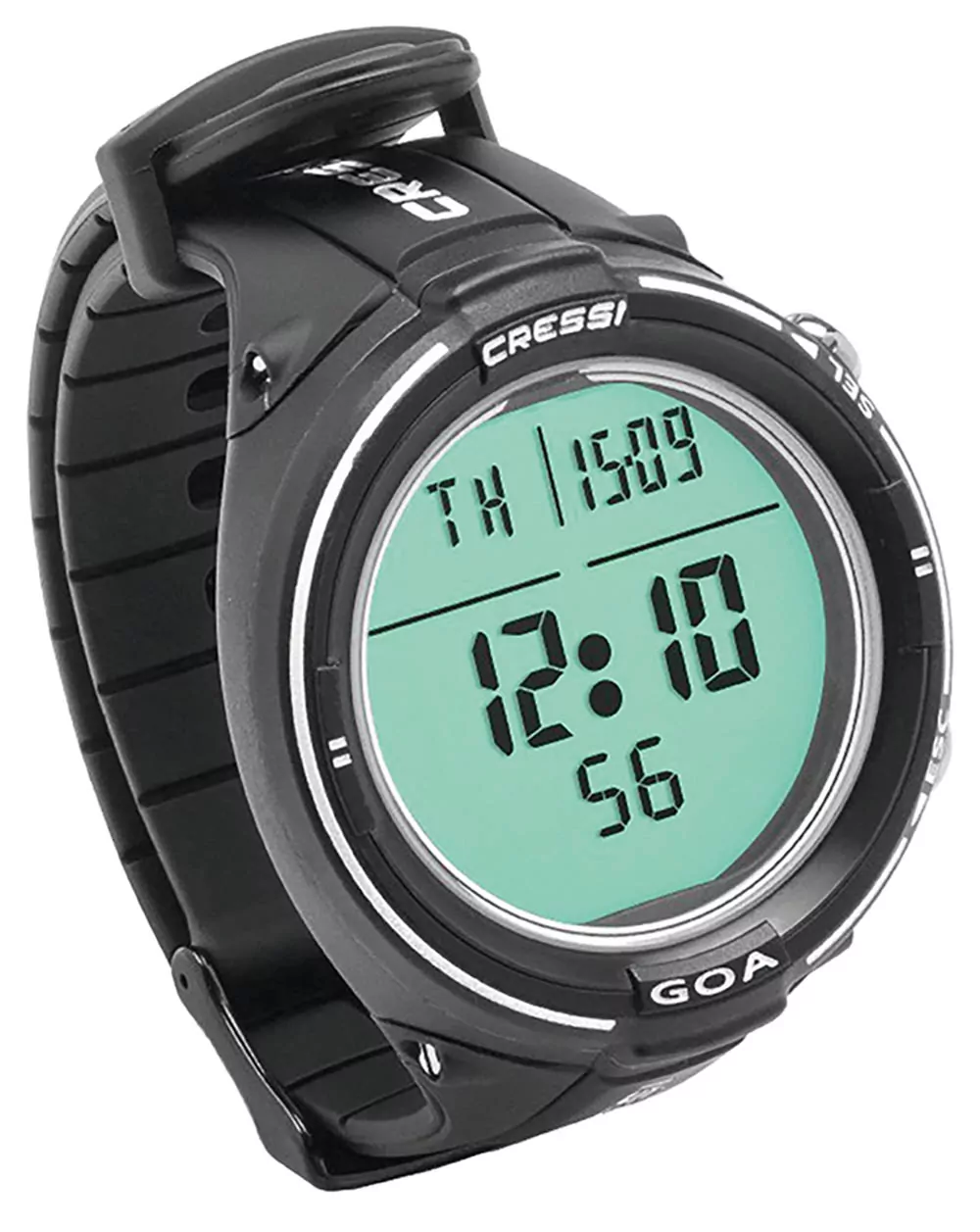
Appeared in DIVER June 2018
CRESSI IS ONE OF THE OLDEST diving-equipment companies. Italian brothers Edigio and Nanni Cressi began making freediving and spearfishing kit in the late 1930s. After WW2 they founded Cressi-sub and started producing recreational scuba gear as well as military kit, such as oxygen rebreathers.
As a 1970s child my local sports shop outfitted me in Cressi’s classic blue Rondine swim-fins with the famed swallow logo, and a Pinocchio face-mask, the first to feature a nose-pocket for equalisation – invented in 1952 and still made today.
Cressi equips many dive-schools, a sign of the brand’s solid performance. The name changed from Cressi-sub to Cressi to reflect the company diversifying into swimming equipment and playing to a wider market than divers alone.
The Design
The Goa is the firm’s entry-level multi-mode watch-style dive-computer. It offers Air, single-mix Nitrox, Gauge and Freediving options. As a digital wristwatch it’s designed for everyday wear, with the normal functions of a basic timepiece. It is not gas-integrated.
The march of ever-cheaper technology means that the Goa, though inexpensive, is “feature-rich”, and for many recreational divers the specification will comfortably exceed their needs. In fact there are so many features that my review has to concentrate on those key ones most likely to interest leisure divers.
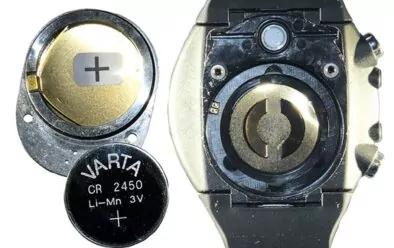
I got to know the Goa over a series of 11 no-stop and decompression dives off Gibraltar with the support of PADI centre Dive Charters and Gibraltar SAC. I’m not a technical diver – that’s my diver co-tester Mike Ward’s department – but I’m trained in basic nitrox and often make dives with short deco-stops of up to 20 minutes. On the face of it, the Goa would seem a very attractive option for divers like me.
It is built from ABS with stainless-steel buttons and rated to 120m. A replaceable plasticised shield protects the mineral-glass display-screen from damage.
The shield threads onto the strap, so is near-impossible to lose but easily swapped should it be damaged. The decent-length strap should fit over most people’s wrists, even when wearing thick suits.
Getting Started
Like any computer the Goa has to be user-programmed to ensure that it does what you want, how you want and when you want it.
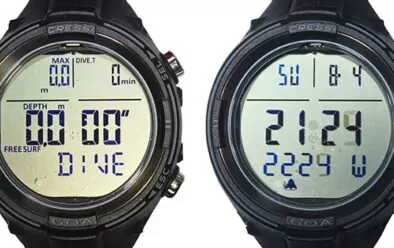
The menus are driven by two push-buttons. You use them a little like Morse code – short and long presses with occasional beeps to help you along.
As with any menu-driven system, it took me a while to get the hang of them. I tried the buttons with 5mm gloves and they worked very well.
Menus, whether for dive-computers, cameras or phones, all have their quirks. For a tester, one problem is unlearning that with which you’re already familiar.
With a little practice the Goa proved fairly easy to navigate, though the buttons will leave imprints on your fingers while you’re learning.
A nice touch for travellers is that the watch can display two time-zones simultaneously, in 12- or 24-hour formats.
The main time-display is huge, occupying the centre of the face, with the second time-zone laid out a little smaller below, indicated by a W for World. Day and date are displayed at the top.
You can set an alarm to wake you up or remind you when you need to be ready to dive next. This is linked to the primary time-zone, so you need to get that right. There is also a stopwatch function.
A watch-style computer will be used more as a timepiece than for diving, but it’s how the Goa performs in its dive-modes that concerns us here.
Deco Basics
The Goa has a proprietary decompression algorithm. It calculates gas-loading across nine compartments with half-times from 2.5 to 480 minutes. These compartments attempt to model how much nitrogen gas is being absorbed, held or released by different parts of your body during, between and after your dive.
On the dive, different compartments come into play at different times. The one that dictates when your Goa will indicate that you are approaching your no-stop time, or how much decompression you must do, is the one that reaches its limit for that profile first.
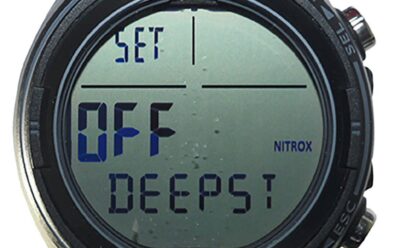
During your dive, the baton is usually passed from one compartment to the next – the reason you see sudden changes in your no-stop times, for example, as you change depths. When the last compartment to retain any nitrogen after surfacing has given all of it up, you have completely desaturated.
The longest half-time of 480 minutes means that the Goa can take as long as 48 hours to fully desaturate. For sports divers, this compartment is typically used to track multi-day, multi-dive profiles, such as during a liveaboard trip.
These multiple dives can be considered as one long yo-yo dive – a single dive over many days with a lot of surfacing in-between. The slow compartments can accumulate enough nitrogen to be significant in this time, and the Goa tries to account for these and keep you safe.
The RGBM aspect of the algorithm stands for Reduced Gradient Bubble Model. You absorb gas as a result of the difference between the pressure at which you’re diving and inhaling gas, and the pre-existing pressure in your body tissues, which starts off lower. The gas is trying to seek equilibrium and match those two pressures.
The gradient refers to this difference in pressure between the gas you’re inhaling and that of the gas already in your tissues.
High pressure always moves towards low, so nitrogen is forced into your body tissues as you descend, and pressure increases. This takes time, because each compartment’s absorption rate differs, hence using nine different half-times.
Reducing pressure, by ascending, reverses the process and creates excess pressure in your tissues.
Each compartment can also tolerate a differing amount of excess nitrogen. As pressure drops around you, nitrogen held in your tissues begins its journey of leaving them, travelling in your blood to your lungs to be exhaled.
It’s during the ascent phase and on the surface after your dive that bubbling, which can cause decompression illness, occurs. Instructors often demonstrate this with the classic popping the top off a shaken fizzy drink. The RGBM permits less of a pressure differential – the gradient – to occur, and claims to minimise the formation of bubbles.
Decompression theory, knowledge and experience is constantly evolving, and dive-tables, computers and diving procedures get modified to reflect this.
You can program the Goa to make deep stops for decompression diving. Many technical divers believe that deep stops reduce the risk of a bend, but I chose to turn off this feature.
Under Water
The Goa presents must-know information clearly and succinctly. I dived it in Air mode only – on no-stop dives I’m mostly interested in current depth and remaining no-decompression time, and these are displayed across the centre of the screen in place of the main time display.
Above, in smaller type, are maximum depth and elapsed time – less important unless coping with tides or diving with one of those operators that time-limits your dive.
Temperature is tucked into the lower face. I’ve never cared for this – occasionally it might make me feel smug in the tropics, but mostly it just confirms that I’m cold.
As you approach a no-decompression limit (NDL) of three minutes, the Goa sounds an audible alarm to warn you, so you can begin your ascent if you wish to avoid mandatory stops. There are audible and visual alarms to warn you if you exceed the recommended ascent rate.
The Goa will also flash up a SAFE logo once you ascend into the safety-stop range and holds you there for three minutes, counting it down.
Once you enter decompression, the display changes to indicate the depth and time of your deepest stop and your total ascent time.
This information helps you manage your deco schedule to ensure that you have enough gas to complete your deco safely.
I’m in my mid-50s and should have reading lenses in my mask. I could easily read the total ascent time and see when I’d reached the depth of my stop, but the depth and time of the first-stop display uses smaller icons, and I ended up reading these through a camera close-up lens.
It’s a credit to Cressi that it has managed to keep the Goa as easy to read as it has, given the constraints imposed by a watch-sized casing.
Setting Nitrox
The Goa is designed for diving one gas at a time – either air or one nitrox mix – and you can change mixes between dives at the surface but not during dives. Choosing nitrox means that you have to set both the oxygen percentage and your preferred maximum O2 partial pressure yourself.
Unlike some other computers I’ve owned, setting these is intuitive. You can set partial pressures of oxygen of 1.2 to 1.6 bar and percentages of 21 to 50%.
Plan Mode
The planning function is basic. You can check your no-decompression limits between dives, but you can’t run a simulated dive to see, for example, how much deco you’ll incur if you overstay the predicted NDL.
The Goa is a very capable decompression computer, with the ability to make stops as deep as 24m, but its target market probably isn’t going to be deco-diving that much, so the inability to simulate such dives in advance is unlikely to be a deal-breaker.
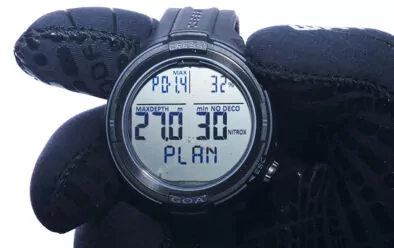
For the type of deco-diving I occasionally do professionally, I’d be perfectly happy to rely on the Goa.
Safety Features
One of several safety features is altitude, which you need to program in, because the Goa does not adjust automatically. You can also program in different levels of safety factors, which reduce gas-loading for shorter NDLs and, I suspect, longer deco-stops.
This might be advisable if you’re elderly, tubby, getting cold or making strenuous dives, such as swimming against current, so I should have used it.
It’s the same advice as divers using tables are given to help compensate for factors that can predispose them towards a bend.
A glance at your Goa screen will inform you if any of these parameters has been set or cancelled by accident.
As an underwater photographer frequently frustrated by an unnoticed button-press launching my camera into useless functions unknown to man, or at least to me, I’m very conscious of doing the same thing with menu-driven computers of any brand, so it’s important to check the display before diving.
All vital information, such as partial pressure, mix, altitude and safety factor are clearly displayed. Cressi has also done a good preventative job of separating the menus to reduce the likelihood of a mistake being made.
This is especially important because it’s possible to reset the Goa’s algorithm to zero, meaning that it has no memory of previous dives, so that it can be used as a rental unit.
The Goa will lock you out for 48 hours if you violate it, such as missing a decompression stop.
According to the manual, there’s a possible gotcha. If you set the unit to Freediving mode and go snorkelling, it will lock you out of air- and nitrox-diving for the next 24 hours.
I often snorkel between dives. I appreciate that there is a theoretical bends risk, but I’ve no idea when it becomes significant. I’m not making repeated, long deep freedives, and I would simply not wear the Goa for snorkelling on a dive-trip. Complaints to the Editor, please.
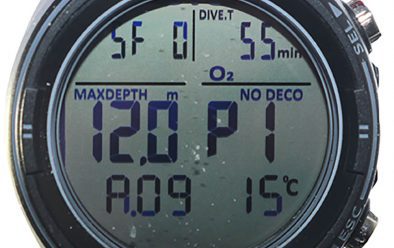
If you want to go surface-swimming, you can set your Goa accordingly so that it doesn’t get confused.
Logs
The Goa records four separate logbooks – one each for Air, Nitrox, Gauge and Freediving modes, with their own set of parameters for the information it can record. It logs 100 individual submersions when freediving and 50 each of your dives in the other modes, which should be enough. I didn’t have the optional link for downloading.
The battery, a common CR2450, can be user-changed. You access the chamber via two slot-head screws. I tried it and it’s straightforward, though the tiny screws would be easy for someone like me to lose.
I would prefer a coin-slot twist-off back, but it’s a minor gripe, given how rarely you’ll need to swap batteries.
I’ll assume that the Goa’s low battery-warning indicators work as advertised. If you’re inattentive and have to change a battery between dives, you’ll need to discontinue diving for 48 hours in line with the longest half-time.
Conclusion
I racked up eight hours diving on the Goa and found it to be a nice machine.
The dive-planning is a little limited, but apart from that there are a lot of laudable features packed into it.
For no-stop and stage-decompression-diving on air or single-mix nitrox it exceeds my needs.
As a keen snorkeller, I would also enjoy the Goa’s Freediving mode.
Recommended.
Specs
TESTER> Steve Warren
PRICES> £276
ALGORITHM> Cressi – Wienke RGBM
COLOUR> black-grey,black-white, black-blue, white-pink, white-purple.
CONTACT> cressi.com
DIVER GUIDE> 7/10

